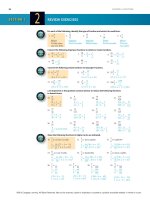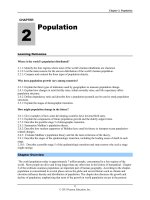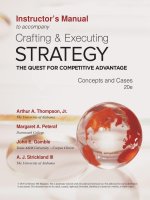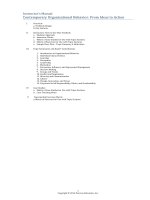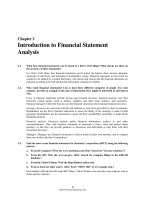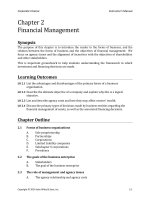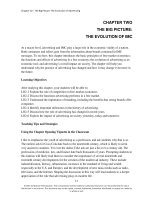Test bank solution manual of contemporary organizational behavior (2)
Bạn đang xem bản rút gọn của tài liệu. Xem và tải ngay bản đầy đủ của tài liệu tại đây (1.12 MB, 19 trang )
Instructor’s Manual
Contemporary Organizational Behavior: From Ideas to Action
I.
Overview
a. Textbook Design
b. Key Features
II.
Instructors: How to Use This Textbook
a. Modular Approach
b. Instructor Choice
c. Matrix of Case Studies for Use with Topic Sections
d. Matrix of Exercises for Use with Topic Sections
e. Sample Class Plan – Topic Summary 6 Motivation
III.
Topic Summaries and Expert Contributions
1. Introduction to Organizational Behavior
2. Individual Characteristics
3. Learning
4. Perception
5. Leadership
6. Motivation
7. Persuasion, Influence, and Impression Management
8. Decision Making
9. Groups and Teams
10. Conflict and Negotiation
11. Diversity and Communication
12. Culture
13. Change, Innovation, and Stress
14. Corporate Social Responsibility, Ethics, and Sustainability
IV.
V.
Case Studies
a. Matrix of Case Studies for Use with Topic Sections
b. Case Teaching Notes
Experiential Exercises Matrix
a. Matrix of Exercises for Use with Topic Sections
1
Copyright © 2016 Pearson Education, Inc.
I. Overview
a. Textbook Design
Contemporary Organizational Behavior: From Ideas to Action was built on three simple ideas:
1. Build a text around a few key ideas for each topic (rather than a laundry list of terms).
2. Invite recognized OB experts and thought leaders to write original contributions about how their ideas
relate to contemporary organizations. These contributions might include a description of how an OB
concept applies in organizations or it might provide a more robust explanation of a concept. The
contribution might involve relating a stream of research to a key OB idea or an author offering insights on
how they teach a particular OB concept in their own class.
3. Create breathtaking case studies and experiential exercises that help students apply the concepts to
their own experience with the goal of improving their own understanding of organizational behavior.
With these ideas in mind, Contemporary Organizational Behavior provides the first organizational behavior
textbook designed specifically for today’s learner and instructor. Not your typical textbook, the volume is broken
into topic sections, rather than traditional chapters. Each topic section contains a short, engaging summary of the
central concepts, two to four authoritative readings from topic experts, a real-world case study from a
contemporary organization, and experiential exercises that bring topic concepts to life. Whether undergraduates
or graduate students, each topic section helps learners experience life in contemporary organizations. The book
is designed with learning in mind, as each topic section engages the learning cycle: experiencing through
exercises, reflecting on personal experience, drawing on theory, and applying through case studies.
b. Key Features
1. Covers fourteen key organizational behavior topics.
2. Each topic includes a main body written by the textbook authors and 2-4 articles authored by an expert in
the topic covered. Rather than having the entire book authored by one scholar (as in traditional texts),
each topic is enhanced with specific readings by scholars that specialize in a narrow topic area.
3. Perfect for professors seeking to supplement lectures but still want theory . . . also perfect for a ‘topical’
readings course.
4. Can be customized or used as a traditional text complete with case studies, exercises, and online support
material.
II. Instructors: How to Use This textbook
a. Modular Approach
The text is organized into three modules:
Topic Summaries & Expert Contributions – brief overviews of key theory, research, and terms on a
given topic are accompanied by original works written by experts in Organizational Behavior that put
theory, research, and concepts in a contemporary context.
Case Studies – engaging cases written by author Kim Elsbach, Ph. D, and other experts.
Experiential Exercises – a collection of easy to facilitate exercises to use in class to get your students
acclimated to working in groups.
2
Copyright © 2016 Pearson Education, Inc.
b. Instructor Choice
Adaptable to Your Students’ Level of Experience
The unique format allows the instructor two options:
1. The instructor can follow a pre-existing template of topics or
2. The instructor can create a unique custom text by mixing and matching topic summaries and readings
with the case studies and experiential exercises that are just right for your students’ level of
experience.
A matrix of case studies matched to topics and a matrix of exercises matched to topics provide guidance and
suggestions on how to use the book. The matrices are included in both the textbook and at the end of this
Instructor’s manual. The design of the book includes content that discusses concepts, theories, and terms, as well
as providing experiential components for students to experience the content. This allows each topic section to
engage the learning cycle: experiencing through exercises, reflecting on individual experience, drawing on theory,
and applying through case studies.
Instructor Process
Assign Topic Summary
Assign One or More Expert
Contributions
Select a Case Study and/or
Experiential Exercises
Each topic provides opportunities for student learning. This learning can be applied through many instructor
choices. We have provided a sample detailed class plan for Topic Summary 6, Motivation. Some of your choices
from Contemporary Organizational Behavior: From Ideas to Action for the application of concepts include:
Topic
Summary
•Utilize the OB at Work Feature to discuss practical
application of OB concepts
•Assign discussion questions from the Spotlight on
Research for small group or class discussion
•Design written assignments to test the students’
understanding
Expert
Contribution
•Select one or more expert readings
•Discuss the expert readings in class or in teams
•Design written assignments to test the students’
understanding
•Select a case study from the case matrix and
relevant topic questions
•Discuss the case study in class or in teams
•Design written assignments to test the
students’ understanding
•Select one or
more
exercises
•Conduct
exercise(s)
fully in class,
or assign the
exercises
outside of
class
Case
Studies
Exercises
3
Copyright © 2016 Pearson Education, Inc.
c. Matrix of Case Studies for Use with Topic Sections
Case
Topic
Summary
1. Introduction to Organizational
Behavior
2 Individual Characteristics
3. Learning
4. Perception
5. Leadership
6. Motivation
7. Persuasion, Influence, and
Impression Management
8. Decision Making
9. Groups and Teams
10. Conflict and Negotiation
11. Diversity and Communication
12. Culture
13. Change, Innovation, and Stress
14. Corporate Social
Responsibility, Ethics, and
Sustainability
Case 1
The Case
of Apple
iPhone 4
Case 2
“We Are
Global or
We Are
Nothing”:
Conflict and
Cover-Up at
Colequarter
Maine
Case 3
EMERGENCY!
We Need a
Better
Compensation
System
Case 4 Face
Time at
TechPoint
Software,
Inc.
Case 5
Whatever
Happened to
One of the
“100 Best
Companies
to Work
For”? A Case
Study of
HewlettPackard
Case 6
NASCAR’s
Drive for
Diversity:
Can They
Reach the
Finish
Line?
Case 7
Perceptions
of Leaders
Following
Public
Failures: A
Tale of Two
Coaches
Case 8
Conflict in
Santa’s
Workshop:
Learning to
Be a Team
Player at
ToyKing
X
X
X
X
X
X
X
X
X
X
X
X
X
X
X
X
X
X
X
X
X
X
X
X
X
X
X
X
X
X
X
X
X
X
X
X
X
X
4
Copyright © 2016 Pearson Education, Inc.
X
X
X
X
X
X
X
X
X
X
X
X
X
X
X
d. Matrix of Exercises for Use with Topic Sections
Topic
Summaries
______________
Exercises
1. Big Five
Celebrity
Spotlight
2. Creating My
Brand
3. My Expat
Assignment
4. How Leaders
Effect You
5. My Best and
Worst Learning
Experiences
6. Developing
Your Career—
Leadership
Development in
Action
7. Development
While in College
8. Facts and
Opinions
9. Being Positive
1.
Introduction
to
Organizational
Behavior
2.
Individual
Characteristics
5.
Leadership
6.
Motivation
X
7.
Persuasion,
Influence, and
Impression
Management
8.
Decision
Making
9.
Groups
and
Teams
10.
Conflict and
Negotiation
11.
Diversity
and
Communication
X
X
X
X
X
X
X
X
X
X
X
X
X
X
X
X
X
X
X
X
X
X
X
X
X
X
X
X
X
X
X
X
X
X
X
X
X
X
X
X
X
X
X
X
X
X
X
X
X
X
X
X
X
X
X
X
X
X
X
X
X
28.
Communication
Breakdown
30. You Can’t
Handle the
Truth
31. The Ethics of
the Climb
14.
Corporate
Social
Responsibility,
Ethics, and
Sustainability
X
24. Find the
Artifacts
25. Back-to-Back
Change
29. Diversity
Rocks
13.
Change,
Innovation,
and Stress
X
17. Design Your
Technology
18. Team
Performance
Evaluation
19. Overcoming
Resistance
26. Social Media
Dilemma
27. Develop
Your
Professional
Code
12.
Culture
X
X
14. Laughter Is
the Best
Medicine
20. Employment
Branding
21. OD
Techniques at
Work
22. A Clash of
Cultures
23. What’s Your
University’s
Culture?
4.
Perception
X
10. Force Field
Analysis
11. Bias and
Decision Making
12. Well-Being
at Work
13. What
Stresses You
Out?
15. Building My
Network—
Individual
16. Writing a
Team Contract
3.
Learning
X
X
X
X
X
X
X
X
X
X
X
5
Copyright © 2016 Pearson Education, Inc.
X
X
32.
Mindmapping
33. Could I Be a
Whistleblower?
X
X
X
X
34.
Sustainability
Practice at Work
X
35. Who Do I
Fire?
36. What Are My
Values
37. Team
Survival
Simulation
38. Federal
Intelligence
Simulation
X
X
X
X
X
X
X
X
X
X
X
6
Copyright © 2016 Pearson Education, Inc.
X
X
X
e. Sample Class Plan
Topic Summary 6: Motivation
Topic Summary Learning Objectives
Recognize factors associated with motivation in organizations.
1. Recognize the importance of internal, social, and organizational factors associated with motivation in
organizations.
2. Compare the motivation theories based on internal factors.
3. Identify theories based on social factors.
4. Describe how organizational factors, job characteristics, and managerial beliefs can impact motivation.
5. Apply the concepts of motivation to organizations.
Student PreWork
Read Topic Summary and these Readings:
*1. Expert Contribution on Creating a Happy,
Stress-Free Workplace: It’s a Matter of Perspective
– D. Keith Denton (Missouri State)
Note to Instructor
* Assign one or more readings from the expert
readings
2. Expert Contribution on Moving Beyond the
American Dream: How Intrinsic and Extrinsic
Aspirations Relate to Psychological, Social, and
Physical Health – Christopher P. Niemiec
(University of Rochester), Bart Soenens (Gent
University), & Maarten Vansteenkiste (Gent
University)
3. Expert Contribution on High-Tech, High-Touch
Tension: Trends in Human Resource Management
– Troy R. Nielson (Brigham Young University),
Ellen Ensher (Loyola Marymount University), &
Elisa Grant-Vallone (California State University,
San Marcos)
4. Expert Contribution on Trade-Offs in Using Pay
for Performance – Kimberly D. Elsbach
(University of California, Davis)
Class Lecture
Class Discussion
PowerPoint slides available on the Instructor Resource
Center
OB at Work from Topic Summary Discussion
Pearsonhighered.com/irc
Questions for Discussion from OB at Work:
1. How does Nicole’s experience relate to the
topic of motivation?
2. What experiences have you had trying to
motivate other people in the workplace?
Spotlight on Research from Topic Summary Discussion
Questions for Discussion from Spotlight on
Research:
Expert Contributions Questions
1. How might you explain some of the
demographic differences relative to motivation?
(e.g., gender, age, etc.) Why do you think this?
2. How would you apply this research to your
workplace? What should managers consider
about motivation differences?
Creating a Happy, Stress-Free Workplace: It’s a
Matter of Perspective
1. How can leaders create a better work
environment for the ‘very happy’ group as well
as all others in the workplace?
7
Copyright © 2016 Pearson Education, Inc.
Moving Beyond the American Dream: How
Intrinsic and Extrinsic Aspirations Relate to
Psychological, Social, and Physical Health
1. How does SDT explain motivation?
High-Tech, High-Touch Tension: Trends in
Human Resource Management
1. Employers will often check an applicant’s
Facebook page and LinkedIn profile (as well as
doing a Google search) once that person reaches
a certain stage in the hiring process—what
“brand message” do these pages communicate
to prospective employers about you?
2. How does technology influence your ability to
balance professional and personal demands?
What do you see companies do with technology
to reduce or increase work-life conflict?
3. If you were an HR leader, to what extent
would you recommend that employee usage of
company technology resources be monitored?
Why?
4. How can you use technology to better take
charge of your career development?
Trade-Offs in Using Pay for Performance
1. What are some of the trade-offs associated
with pay for performance?
Class Exercise
**What are My Values? Found in the third section of the
textbook
Facilitate Case
Discussion
***NASCAR’s Drive for Diversity Found in the second
section of the textbook
Exercise with Questions for Individuals and
Groups in Text **Exercises can be selected from
the Exercise Matrix
1. How can NASCAR motivate sponsors to
support their D4D program?
2. How can NASCAR better motivate fans to
support diversity as a value?***Cases can be
selected from the Case Matrix
8
Copyright © 2016 Pearson Education, Inc.
9
Copyright © 2016 Pearson Education, Inc.
III. Topic Summaries and Expert Contributions
Part 1 Introduction
Topic Summary 1: Introduction to Organizational Behavior
Topic Summary: Introduction to Organizational Behavior
Organizational behavior emerged as a distinct field of study in the 1940s. Because
organizational behavior is an interdisciplinary study, this means that it draws from
different disciplines in order to understand organizations from multiple
perspectives and viewpoints. As an interdisciplinary study, organizational behavior
draws from psychology, sociology, anthropology, economics, political science,
strategy, management, and even the natural sciences. All types of organizational
members benefit from understanding organizational behavior. This topic summary
will help you understand processes studied by the field of organizational behavior
and how improving these processes may lead to improved individuals, groups, and
organizations.
1. Explain the skills needed for the changing workplace and how you can develop these
skills.
Answer:
Skills Needed for the Changing
Workplace
Adaptability and flexibility
Relevant Contemporary
Organizational Behavior Topic
Organizational change, learning,
individual characteristics
Problem solving and critical thinking
Individual characteristics, decision
making, negotiation, learning
Leadership
Leadership, persuasion, influence
& impression management
Professionalism
Individual characteristics,
organizational culture, motivation,
persuasion, influence, and
impression management
Teamwork
Groups and teams, organizational
culture, communication and
diversity
10
Copyright © 2016 Pearson Education, Inc.
Communication
Communication, perception,
persuasion, influence, and
impression management,
negotiation, individual
characteristics
Innovation
Individual characteristics,
leadership, and organizational
change and innovation
Diversity
Diversity, learning, organizational
culture
Ethics
Corporate social responsibility
and ethics, organizational culture,
decision making, leadership
Learning
Learning, individual
characteristics, perception,
motivation
Health and wellness choices
Stress, motivation, individual
characteristics
2. Describe the types of contemporary organizations and give some examples of each
type.
Answer:
Type of Contemporary
Organization
Description
Example
Community of practice
Group of people who share
an interest in a topic and
interact together on the
topic
Associations,
international
development,
education
Hybrid
Form of organization that
combines two or more
forms. May consist of a
team structure embedded
in a formal hierarchical
structure.
Technology firm,
some corporations
11
Copyright © 2016 Pearson Education, Inc.
Network
An organization with a
shared responsibility,
equal status among
members, and shaped
more by the activities of its
members than by its
hierarchy
Technology firms,
craft organizations
Bureaucratic
An organization with
specialized roles, and a
command and control
structure with formal
hierarchy
Professional
A public or private
organization that consists
of people with strong
professional norms and
similar professions
Healthcare, law, and
higher education
Representative democratic
An organization based on
the principles of employee
autonomy, participation,
and even profit-sharing or
shared ownership
Credit unions, foodcoop
U.S. government
agency, armed forces,
some corporations
3. What is an organization?
Answer: An organization is where people interact and coordinate in order to
achieve a purpose.
4. Organizations share one attribute – what is it?
Answer: All organizations share one attribute: organizations require people
interacting with one another.
5. What are four dynamic organizational processes that shed light on life in
contemporary organizations?
Answer: There are four dynamic organizational processes that shed light on life in
contemporary organizations. Individual processes describe individual differences
in characteristics, learning, and perception. Leading and leadership processes
describe the factors that impact differences in leadership, motivation, persuasion,
influence, impression management, and decision making. Interpersonal processes
refer to the pattern of interactions among individuals that includes groups and
teams, negotiation, and communication and diversity.
12
Copyright © 2016 Pearson Education, Inc.
************************************************************************************
****************************
Expert Contribution on Challenges of Leadership: The Relevance of
Organizational Behavior
David L. Bradford (Stanford University)
Leadership means dealing with an increasingly complex, uncertain world that is
making more and more personal demands on those who want to manage.
Furthermore, there can be no book, no four- or two-year program that can predict
all the future challenges. As we have stressed, learning has to be continuous
throughout a person’s career. The mental models must change as one progresses in
an organization or moves to a new field. This demands new competencies and
flexibility to fit one’s style into different situations. This includes a willingness to see
experiences as potential learning opportunities. It demands the ability for selfreflection and openness to feedback. Organizational behavior can provide the
framework for that rich learning.
1. Explain what is changing in the world that leaders face today?
Answer: Increasing globalization means organizations are faced with new
competitors, new markets, and more stringent government regulations.
Disruptive technologies can destroy industries almost overnight; for example, the
video distribution business. Cell phones now replace banks as a way to transfer
money within Africa or allow farmers in India to check market prices—freeing them
up from the tyranny of middlemen buyers.
The increasing interdependence of the world’s economic systems means that an
event in one place impacts others in distant places. A tsunami in Japan disrupts auto
production in the United States and Europe. A popular rebellion in northern Africa
spikes oil prices. Bankruptcy in Italy could destroy the Euro and cause a worldwide
recession
Knowledge is becoming obsolete at an astonishing rate. Half of the “facts” that
engineering undergraduates learn in their first year will be outdated by the time
they graduate.
2. How can contemporary leaders, who can’t have all the answers but who are still
held accountable for results, still be open to others’ ideas without totally giving way
to them?
Answer: A clear vision and specific strategic and business plans can serve as partial
guidelines, but there are still many decisions on how to implements those plans. In
exploring the assumptions behind one’s mental models and seeing the effect of one’s
behavior, it is possible to gain clarity as to the values behind one’s intentions and
actions. That clarity on personal values can serve as an important foundation when
faced with multiple options and different pressures. This provides a consistency
without rigidity, since the same value can be expressed in different ways in different
situations.
13
Copyright © 2016 Pearson Education, Inc.
************************************************************************************
****************************
Expert Contribution on How Companies Keep on Winning: A System for
Developing Global Leaders
Robert Fulmer (Duke Corporate Education)
Key research, along with other studies, have shown a high degree of innovation
designed to address strategic challenges in developing high-performing leaders.
There are increased levels of competition and pressure for change, along with new
demographic and generational differences. The best companies practice “innovative
imitation" to gain competitive advantage from their business and leadership
development activities by consistently using strategic, systemic coordination to
develop their high potential global leaders. In this reading an overview of key
insights about how the leading global firms go about developing their potential
leaders is discussed. Both a backdrop from previous research on the subject and an
overview of key findings about emerging, innovative best practices from leading
firms are outlined.
1.
Why do high-performing firms tie leadership development closely to their business
strategies?
Answer: High-performing firms engage in leadership training and development
because they believe such practices are a part of their long-term strategies for
success.
2.
What is the first step to linking leadership development to a firm’s strategic vision?
Answer: The first step is to develop an awareness of leadership development
programs used by other firms.
3.
Why do firms utilize the expertise of the American Productivity and Quality Center
(APQC)?
Answer: APQC maintains the world’s largest database of benchmarks for real-time
performance metrics. APQC can provide instant benchmarks to help firms
determine where their organization stands in terms of leadership performance, as
well as online tools that compare the company’s own data with that provided by
peers. In an effort to make best practices widely available, they have sponsored a
variety of best practice studies.
Part 2 The Individual in the Organization
Topic Summary 2: Individual Characteristics
Topic Summary: Individual Characteristics
14
Copyright © 2016 Pearson Education, Inc.
Individual characteristics are associated with performance and organizational
success. These characteristics include competencies (knowledge, skills, and
abilities), emotions, personality, and attitudes. Personality is a general term that
includes emotions, attitudes, perceptions, and behaviors. The Big Five suggests that
some individual characteristics are associated with improved performance in
organizations. For example, across all occupational groups, high levels of
conscientiousness predict positive job performance. Individual characteristics of
people help us understand what people think, feel, and do in organizations.
1. What are the twelve competencies most employers are looking for?
Answer:
1.
Critical thinking/problem solving
2.
Creativity/innovation
3.
Leadership
4.
Teamwork/collaboration
5.
Written communications (conveying written messages clearly and
effectively)
6.
Lifelong learning pursuit/self-direction
7.
Information technology application
8.
Oral communications
9.
Ethics/social responsibility
10.
Diversity
11.
English language (spoken)
12.
Writing in English (grammar, spelling, etc.)
2. What is emotional intelligence, and discuss the link to performance.
Answer: Emotional intelligence, sometimes called emotional quotient, or EQ,
involves being able to recognize and respond to social and emotional situations.
Importantly, emotional intelligence as a competency can be developed and changed.
Levels of emotional intelligence can differ across individuals. High levels of
emotional intelligence have been found to be predictive of high performance in
many studies. Emotional intelligence differs from traditional or cognitive
intelligence. Traditional intelligence accounts for only a small percentage of success
in an organization.
3. Explain locus of control, both internal and external, and give some examples.
Answer: The extent to which someone believes that they are in control of their
environment is termed locus of control. If an individual has a high internal locus of
control, they think that they are in control of what happens to them.
Locus of Control and Employee Beliefs
Employees with an internal locus of
Employees with an external locus of
15
Copyright © 2016 Pearson Education, Inc.
control
Bad events are caused by mistakes
Success is caused by effort and hard
work
Poor grades are caused by lack of effort
People can make friends by trying
High performance evaluations are the
result of effort and hard work
control
Bad events are caused by bad luck
Success is about being in the right place at
the right time
Poor grades are handed out and unfair
People like or dislike you; there is little
point in trying
High performance evaluations are the
result of the boss’s whim
************************************************************************************
****************************Expert Contribution on Solving the Introvert
Problem
Laurie Helgoe (Davis and Elkins College)
According to personality type theory, we all use introversion and extraversion. We
just tend to prefer one over the other and use it more often. Sometimes the
preference isn’t evident until the individual is under stress—the introvert wants to
retreat and the extravert wants to talk. Instead of trying to force a universal
language of the workplace, organizational leaders can optimize their human
resources by encouraging a bilingual consciousness. But until introversion becomes
a visible, viable, and valued alternative in the workplace, introverts—and extraverts
in an introverted mood—will not be fully present until they clock out.
1. Personality testing and training, now offered by many organizations, provide a
starting point for change. What can a person learn from this kind of test?
Answer: Personality testing helps individuals recognize how they tick, what helps
them work at their best, and how to work with people who tick differently. But
unless existing assumptions are also put to the test, unspoken biases will undermine
application of the insights.
************************************************************************************
****************************Expert Contribution on Narcissism and Its Role in
Organizations
W. Keith Campbell (University of Georgia) & Stacy M. Campbell (Kennesaw
State University)
Narcissism is a trait linked to grandiosity and entitlement that has a range of
consequences in the workplace. Narcissism is a trade-off. It is primarily a destructive
force, but has some benefits as well. There is a need to control expressions of narcissism
in the workplace (and in ourselves). Although there are some contexts where narcissism
will give us a competitive advantage (like performing in public), most of the time it will
serve to harm those around us.
1. Do narcissistic individuals make effective leaders? Explain.
16
Copyright © 2016 Pearson Education, Inc.
Answer: Narcissistic individuals, on average, do not make effective leaders in the
long term. Narcissistic leaders tend to make risky decisions. When these are
successful, the rewards for the organization can be large; when these are
unsuccessful, however, it can be disastrous. In lab studies, narcissistic leaders are
good at competitive resource extraction. For example, in studies we have looked at
willingness to cut down a renewable forest. The narcissistic leaders cut down the
forest quickly, which can be seen as positive for the company in the short term.
However, the narcissistic leaders destroy the renewable resource more quickly,
which is detrimental for the company in the longer term. Narcissistic leaders also
have, on average, questionable ethics. That is, their lack of empathy and propensity
to exploit others make them more likely to bend the rules when the action will
benefit them. Thus, a link between narcissism and white-collar crime is seen.
************************************************************************************
****************************Expert Contribution on The Importance of Affect at
Work
Donald E. Gibson (Fairfield University) & Sigal G. Barsade (University of
Pennsylvania)
If managers want to address the bottom line, they should follow this rule: Rather
than trying to shut down employee emotions under the assumption that they will
only get in the way of productivity, the enlightened manager needs to understand
his or her own emotions and the emotions of other people. This is the idea of the
emotionally intelligent manager. This manager will have a competitive advantage in
the workplace as he or she will understand that emotions are information and will
be able to use all the cognitive and emotional signals the environment offers to
contribute to effective decision making and management. In addition, the message
for managers from cutting-edge research is mostly that going to work feeling upbeat
and positive can have a demonstrable impact on the people around you, the groups
you work with, and ultimately, your effectiveness. Achieving this happiness at work,
of course, may not be easy. It may mean looking at the people around you in new
ways so that you can see the positive, rather than the negative aspects in others. It
may mean choosing more carefully when you wish to express your irritation. It may
mean saving your anger until it really counts. Yes, workplaces are emotional
because they consist of people who have emotions. What effective managers do is
understand this fact and use that knowledge to enhance their own and the group’s
productivity.
1. At work, people should be focused on rational aspects such as task performance,
operating efficiencies, and objective data analysis rather than emotional aspects
such as the happiness, anger, love, and sadness they may feel in response to what
happens to them at work. Is this true or false? Explain.
Answer: Recent research in management and psychology is showing just how
wrong this view is. Emotions are a critical factor in successful workplace
performance. Employees cannot leave their emotions at home, and more
importantly, managers shouldn’t want them to. Strong feelings are present at any
17
Copyright © 2016 Pearson Education, Inc.
time work issues are confronted that matter to us and our organizational
performance. The current research provides substantial evidence of how emotions
influence managerial actions in a range of areas including decision making, task
performance, leadership, teamwork, and negotiation.
2. As a manager, the ability to “read” and comprehend employees’ emotional
responses and tendencies is not important. True or false? Explain.
Answer: A manager needs to understand when the team he or she is leading is
feeling stressed and needs to have issues addressed, or how to handle particular
team members they know will get defensive and angry when provided with negative
feedback. Managers also need to understand their own emotional responses and
how they are likely to respond to work situations that can be anxiety provoking,
annoying, or energizing. These abilities are grouped under the concept of “emotional
intelligence.”
3. Why do positive states possibly lead to enhanced creativity?
Answer: One theory is that positive affect leads to a state in which more cognitive
material—that is, more variety in the kinds of ideas that come to mind—is available
for processing. Then, once those thoughts are available, positive affect leads to a
more complex, flexible way of thinking, making it more likely that the person will
make use of the ideas that are available and will see a way to bring these diverse
thoughts together in creating a new idea.
************************************************************************************
****************************
Expert Contribution on The Challenge of Managing Emotions in the Workplace
Neal M. Ashkanasy (University of Queensland) & Catherine S. Daus (Southern
Illinois University, Edwardsville)
This article argues that managing emotions in the workplace is both an imperative
and a challenge for managers. Gone are the days when organizational managers can
choose to dismiss emotions as “something we don’t do around here.” Recognizing
and dealing with emotions in the workplace appropriately is now seen to be a
central tenet of effective management. Discussed in detail were the three most
fundamental levels: (1) the day-to-day and moment-to-moment fluctuations
experienced by employees as a result of “affective events”; (2) individual differences
in employees’ and managers’ emotional intelligence; and (3) the need to manage
emotion expression and the effects this has on employee health and well-being.
1. Explain Affective Events Theory (AET).
Answer: AET is an approach to understanding how our emotions impact our work
life. AET, at its core, integrates a strong emphasis on emotion states and traits as
influencing employee attitudes and behaviors/outcomes. Further, according to this
theory, it is often the small, everyday hassles or events like Raul experienced that
influence the way we process job-relevant information, and think and feel about our
18
Copyright © 2016 Pearson Education, Inc.
jobs, employers, and colleagues. In the last decade and a half since AET was first
published, research has solidified support for AET’s main tenets.
2. What are the five recommendations for engendering a healthy and positive
workplace environment?
Answer: They are (1) to build an emotion focus into the organization’s culture; (2)
to understand the emotional impact of jobs on employees; (3) to hire and fire on the
basis of fit with the emotionally healthy organization; (4) to design reward and
compensation systems that encourage a positive and friendly emotional climate;
and (5) to train employees and their supervisors in emotional intelligence skills and
healthy emotional expression. It’s concluded that managers who adopt these five
recommendations are going to be best equipped to meet the challenges of today’s
dynamic and exciting workplace environments.
19
Copyright © 2016 Pearson Education, Inc.
